The AMD Zen and Ryzen 7 Review: A Deep Dive on 1800X, 1700X and 1700
by Ian Cutress on March 2, 2017 9:00 AM ESTBenchmarking Performance: CPU System Tests
Our first set of tests is our general system tests. These set of tests are meant to emulate more about what people usually do on a system, like opening large files or processing small stacks of data. This is a bit different to our office testing, which uses more industry standard benchmarks, and a few of the benchmarks here are relatively new and different.
PDF Opening
First up is a self-penned test using a monstrous PDF we once received in advance of attending an event. While the PDF was only a single page, it had so many high-quality layers embedded it was taking north of 15 seconds to open and to gain control on the mid-range notebook I was using at the time. This put it as a great candidate for our 'let's open an obnoxious PDF' test. Here we use Adobe Reader DC, and disable all the update functionality within. The benchmark sets the screen to 1080p, opens the PDF to in fit-to-screen mode, and measures the time from sending the command to open the PDF until it is fully displayed and the user can take control of the software again. The test is repeated ten times, and the average time taken. Results are in milliseconds.
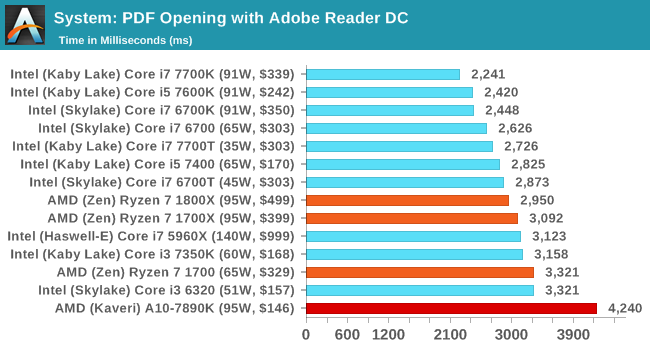
FCAT Processing
One of the more interesting workloads that has crossed our desks in recent quarters is FCAT - the tool we use to measure stuttering in gaming due to dropped or runt frames. The FCAT process requires enabling a color-based overlay onto a game, recording the gameplay, and then parsing the video file through the analysis software. The software is mostly single-threaded, however because the video is basically in a raw format, the file size is large and requires moving a lot of data around. For our test, we take a 90-second clip of the Rise of the Tomb Raider benchmark running on a GTX 980 Ti at 1440p, which comes in around 21 GB, and measure the time it takes to process through the visual analysis tool.
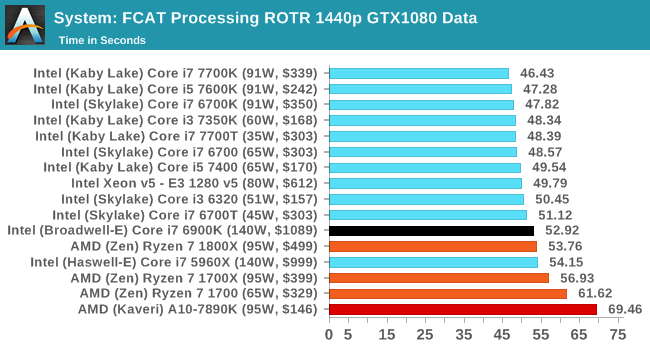
3D Particle Movement v2.1
This is the latest version of the self-penned 3DPM benchmark. The goal of 3DPM is to simulate semi-optimized scientific algorithms taken directly from my doctorate thesis. Version 2.1 improves over 2.0 by passing the main particle structs by reference rather than by value, and decreasing the amount of double->float->double recasts the compiler was adding in. It affords a ~25% speed-up over v2.0, which means new data.
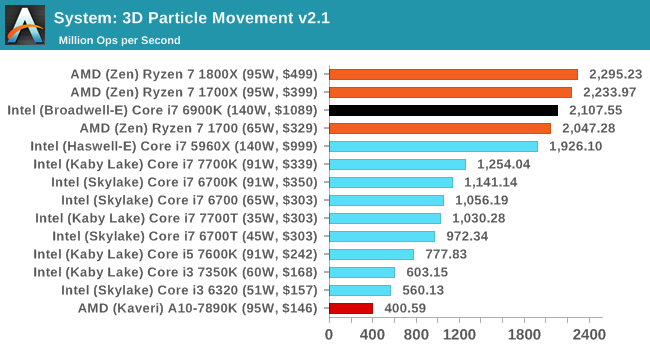
DigiCortex 1.16
Despite being a couple of years old, the DigiCortex software is a pet project for the visualization of neuron and synapse activity in the brain. The software comes with a variety of benchmark modes, and we take the small benchmark which runs a 32k neuron/1.8B synapse simulation. The results on the output are given as a fraction of whether the system can simulate in real-time, so anything above a value of one is suitable for real-time work. The benchmark offers a 'no firing synapse' mode, which in essence detects DRAM and bus speed, however we take the firing mode which adds CPU work with every firing.
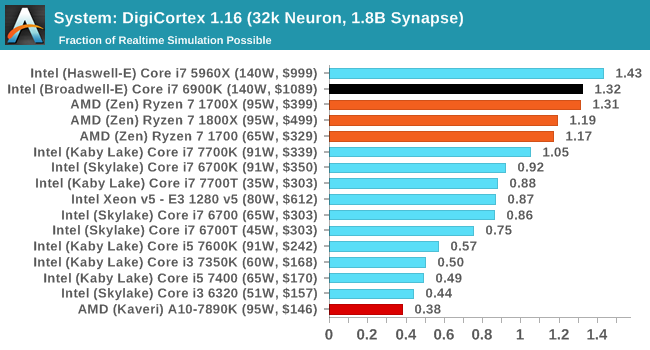
Agisoft Photoscan 1.0
Photoscan stays in our benchmark suite from the previous version, however now we are running on Windows 10 so features such as Speed Shift on the latest processors come into play. The concept of Photoscan is translating many 2D images into a 3D model - so the more detailed the images, and the more you have, the better the model. The algorithm has four stages, some single threaded and some multi-threaded, along with some cache/memory dependency in there as well. For some of the more variable threaded workload, features such as Speed Shift and XFR will be able to take advantage of CPU stalls or downtime, giving sizeable speedups on newer microarchitectures.

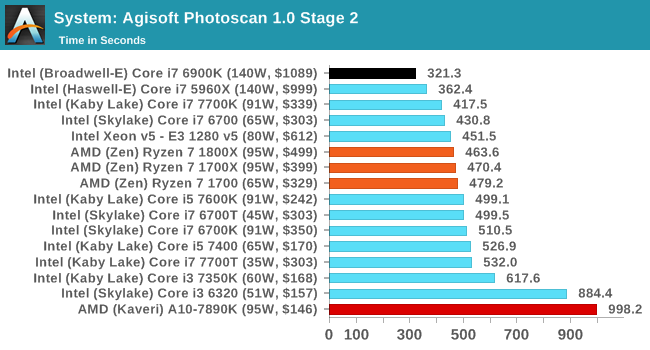
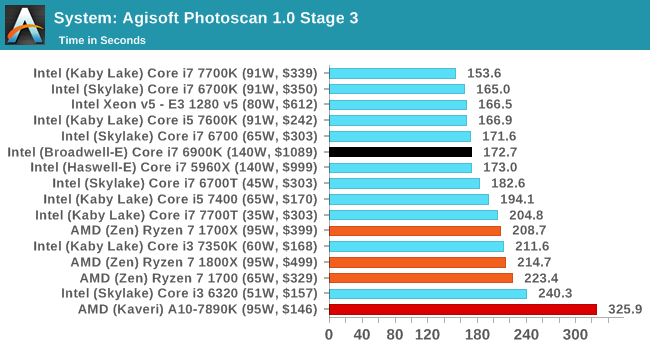
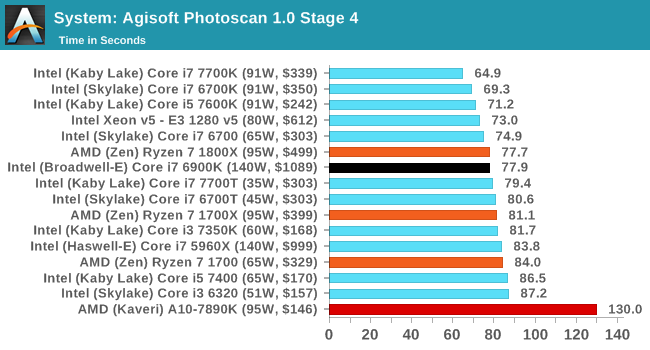
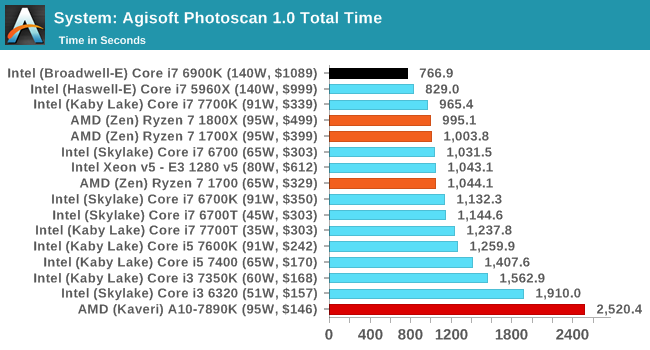










574 Comments
View All Comments
mapesdhs - Sunday, March 5, 2017 - link
If you have a Q6600, I can understand that, but the QX9650 ain't too bad. ;)Marburg U - Monday, March 6, 2017 - link
I'm on a Q9550 running at 3.8 for the past 6 years. I could still run modern games at 1050p, with a r9 270x, but that's the best i can squeeze out of it. Mind that i'm still on DDR2 (my motherboard turns 10 in a few months). I really want to embrace a ultra wide monitor.mapesdhs - Monday, March 6, 2017 - link
Moving up to 2560x1440 may indeed benefit from faster RAM, but it probably depends on the game. Likewise, CPU dependencies vary, and they can lessen at higher resolutions, though this isn't always the case. Still, good point about DDR2 there. To what kind of GPU were you thinking of upgrading? Highend like 1080 Ti? Mid-range? Used GTX 980s are a good deal these days, and a bunch of used 980 Tis will likely hit the market shortly. I've tested 980 SLI with older platforms, actually not too bad, though I've not done tests with my QX9650 yet, started off at the low end to get through the pain. :D (P4/3.4 on an ASUS Striker II Extreme, it's almost embarassing)Ian.
Meditari - Monday, March 6, 2017 - link
I'm actually using a Q9550 that's running at 3.8 as well. I have a 980ti and it can do 4k, albeit at 25-30fps in newer games like Witcher 3. Fairly certain a 1080ti would work great with a Q9550, but I feel like the time for these chips is coming to an end. Still incredible that a 8 year old chip can still hold it's own by just upgrading the GPUmapesdhs - Tuesday, March 7, 2017 - link
Intriguing! Many people don't even try to use such a card on an older mbd, they just assume from sites reviews that it's not worth doing. Can you run 3DMark11/13? What results do you get? You won't be able to cite the URLs here directly, but you can mention the submission numbers and I can compare them to my 980 Ti running on newer CPUs (the first tests I do with every GPU I obtain are with a 5GHz 2700K, at which speed it has the same multithreaded performance as a stock 6700K).What do you get for CB 11.5 and CB R15 single/multi?
What mbd are you using? I ask because some later S775 mbds did use DDR3, albeit not at quite the speeds possible with Z68, etc. In other words, you could move the parts on a better mbd as an intermediate step, though finding such a board could be difficult. Hmm, given the value often placed on such boards, it'd probably be easier to pick up a used 3930K and a board to go with it, that would be fairly low cost.
Or of course just splash for a 1700X. 8)
Ian.
Notmyusualid - Tuesday, March 7, 2017 - link
Welcome to the 21:9 fan club brother.But be careful of the 1920x1080 screens, my brother's 21:9 doesn't look half as good as my 3440x1440 screen.. It just needs that little bit more verticle resoultion.
My pals 4k screen is lovely, and brings his 4GB 980 GTX to its knees. Worse aspect ratio (in my opinion), and too many pixels (for now) to draw.
Careful of second-hand purchases too, many panels with backlight-bleed issues out there, and they are returns for that reason, again, in my opinion.
AnnonymousCoward - Monday, March 6, 2017 - link
Long story short:20% lower single-thread than Intel
70% higher multi-thread due to 8 cores
$330-$500
Mugur - Tuesday, March 7, 2017 - link
Actually, on average -6.8% IPC versus Kaby Lake (at the same frequency) - I believe this came directly from AMD. Add to this a lower grade 14nm process (GF again) that is biting AMD again and again (see last year RX480). Motherboard issues (memory, HPET), OS/application issues (SMT, lack of optimizations).All in all, I'm really impressed of what they achieved with such obstacles.
AnnonymousCoward - Tuesday, March 7, 2017 - link
Just looking at CineBench at a given TDP and price, AMD is 20% lower. That's the high level answer, regardless of IPC * clock frequency. I agree it's a huge win for AMD, and for users who need multicore performance.Cooe - Monday, March 1, 2021 - link
Maybe compare to Intel's Broadwell-E chips with actually similar core counts.... -_-